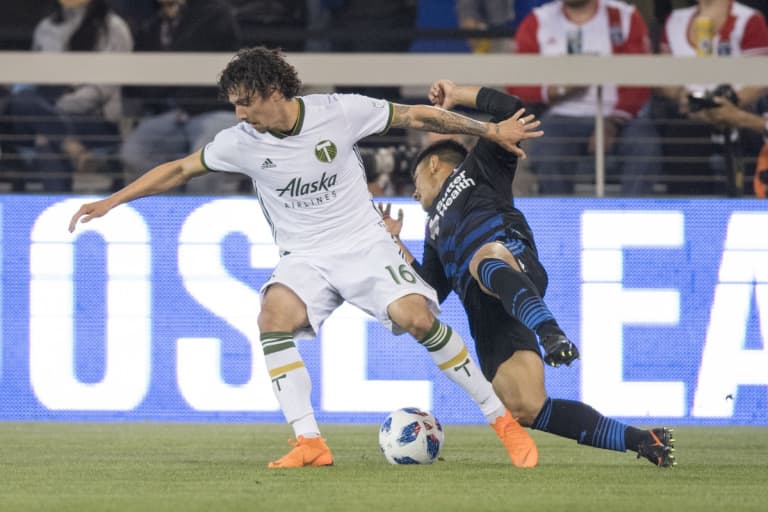Editor's Note: Inside PTFC is a new weekly column – one each for the Portland Timbers and Thorns FC – from soccer writer Richard Farley that dives deeper into the recent successes and challenges each team has been facing. Tactical looks, statistical analysis, rising players and more, Inside PTFC aims to give a closer look into the two teams.
Three weeks ago, after breaking through against Minnesota United FC for their first win of the season, the Portland Timbers had conceded 14 goals through six matches, accumulating one of MLS’ worst defensive records while going 1-3-2. Two games later, Portland has still only conceded 14 times, allowing their goals against average (1.75) to improve to a modest 13th among the 23 teams in Major League Soccer.
Thirteen out of 23 is neither something to laud nor abhor, but in the context of the Timbers’ season, it feels like progress, particularly after an initial six games where the team conceded multiple goals on five occasions. That ranking also prompts some interesting questions about the team’s potential: If you believe the Timbers’ true defensive character was revealed in those initial six matches, the last 189 minutes of goal-free defending probably seems aberrational, and unlikely to continue; otherwise, the last two matches against New York City FC and the San Jose Earthquakes may represent something the team could see more of, going forward.
Where you side on that divide might be a tell: a glass half-full, half-empty test of your fandom. Both conclusions seem defensible, right now, as does a more moderate wait-and-see approach. But if you’re inclined to look for a particular, more positive signal through all this small-sample noise, there are of more markers that hint the Timbers’ good defending is a true change of course.
Consider the opposition the Timbers have faced over their last 180 minutes. We know that New York City’s overall record was good while San Jose’s was poor, but looking more narrowly at teams’ goal-scoring rates, you see sides that were more similar than not. NYCFC has averaged 2.11 goals per 90 minutes when they’re not playing the Timbers, a rate that would be good for fifth in MLS. San Jose’s 1.71 goals per game would be good for eighth. No matter what you think of those teams’ overall play, their attacks have been successful, making back-to-back shutouts against them all the more impressive.
Rank |
Team |
Goals/Game |
|---|---|---|
1 |
Atlanta United FC |
2.56 |
2 |
New York Red Bulls* |
2.43 |
3 |
Houston Dynamo |
2.25 |
3 |
Los Angeles FC |
2.25 |
5 |
New York City FC* |
2.11 |
6 |
Sporting Kansas City |
2.10 |
7 |
Orlando City SC* |
2.00 |
8 |
San Jose Earthquakes* |
1.71 |
9 |
New England Revolution |
1.67 |
10 |
Portland Timbers |
1.62 |
“The unity has been much better,” head coach Giovanni Savarese, after his team’s Saturday win at Avaya Stadium. “Everybody’s covering each other, everybody is working for each other. They sacrifice defensively, and they believe offensively. That’s the key factor, so far.”
There was a more specific element, though, to Portland’s recent defensive efforts that should be encouraging. particularly to those worried about the problems that showed up against the Chicago Fire and Minnesota. In both of those games, though to varying degrees, trouble in wide spaces hurt the Timbers. The lack of pressure on the Fire’s flanks giving players like Bastian Schweinsteiger too much time to create chances, while Minnesota’s halftime adjustments led to too much United success attacking Portland’s wide defenders.
Against New York City, however, Savarese adjusted his team’s shape to reinforce those zones, and against San Jose – a team whose most dangerous weapons play in left and right midfield -- the Timbers again limited chances generated from wide positions.
That’s difficult to tease out in the numbers, but considering the Timbers’ game state over the last two games (having never trailed), there’s still progress to be found. Although teams have been given much more leeway to maintain possession, that possession is leading to fewer crosses, chances and entries into the attacking third, in terms of percentage of play.
Games |
Successful Open Play Crosses |
Chances Created |
"Big" Chances Created |
Passes Into Final Third |
|---|---|---|---|---|
Games 1-6 |
1.81% |
6.05% |
0.99% |
34.66% |
Game 7 and 8 |
1.28% |
3.50% |
0.55% |
23.62% |
“We’ve just got to keep building,” fullback Zarek Valentin said, after the win at San Jose. Valentin has emerged as a regular starter over the season’s first two months, and as occasional injury concerns have affected both left and right back positions, his versatility has been tested. With four straight starts on the left side, though, Valentin’s settling in with the rest of the squad.
“It’s no rest for the weary, as they say, because we’ve had good results …,” he said. “Gio and the staff have done great to help us focus game by game and to really put all of our energy and effort into these results, and they’ve been going well, recently.”
The team has made other changes over the last three weeks, too – both Jeff Attinella and Liam Ridgwell came back into the starting lineup after the Minnesota game – but in continuing to chop away at the issues from their first six matches, the Timbers reached a rare, defensive high mark. You have to go back to Aug. 7 and 15 of 2015 to find the last time the Timbers kept clean sheets in successive wins. Three times in between, Portland had back-to-back shutouts, but in each pair of results, the Timbers had at least one 0-0 draw. It has been two-and-a-half years, though, since games against Chicago and at Real Salt Lake gave Portland six points in consecutive shutouts.

That kind of trivia is more coincidental than predictive, but for those still wrapping their heads around whether the same defense that struggled could produce these shutouts, there’s a more academic, statistical way to look at it. Go back to your college texts, set up a basic difference of means test, and you see a very low chance that the same defensive performance that conceded 14 goals in six games could stumble on consecutive shutout. In terms of significance values (P-value), we’re talking about a nearly 98 percent chance that there’s something different about these two sets of results.
To put it another way, there’s reason to think that the Timbers defense has truly turned corner, doing so in a way that transcends a season’s normal ups and downs. If this were just a fortunate stretch, the ills that surfaced in the team’s first six games would have likely raised their heads once more. Instead, against two strong attacks, the Timbers have kept their opponents off the board, taking a 189-minute scoreless streak into this Sunday's match against Seattle Sounders FC (1pm PT, ESPN).
Ultimately, it still feels too early to draw conclusions about Portland’s defense, as eight games worth of data can still be deceptively small sample. The defense’s past, more recent performances, however, have provided something objective to judge.
From the March’s struggles to spring’s solutions, the Timbers’ defense is starting to change the team’s course, and within the clean sheets of the last two matches, there’s reason to think Portland’s upward trend can continue.












